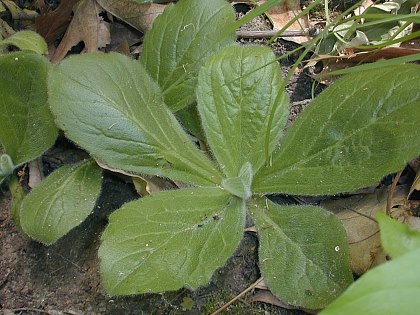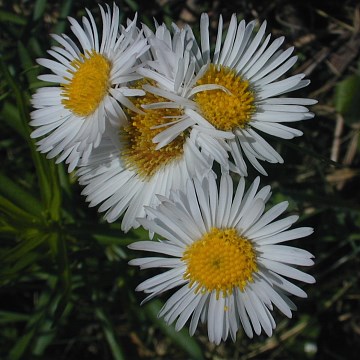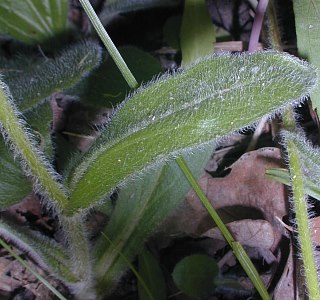Description: This perennial wildflower consists of a rosette of basal leaves that produces a single flowering stalk about ½–2' tall. The basal leaves are up to 5" long and 3" across; they are oval to obovate in shape, medium green on their upper surfaces, and bluntly dentate toward their tips. The alternate cauline leaves are smaller in size than the basal leaves; they are oblanceolate to oblong and clasp the flowering stalk. Both the basal and cauline leaves are more or less pubescent, particularly on their undersides.

The stout flowering stalk is terete, conspicuously hairy, and unbranched; it terminates in a corymb of several daisy-like flowerheads (typically 1-6 flowerheads, but sometimes more). Each flowerhead is ¾–1¼" across, consisting of 50-100 ray florets that surround numerous yellow disk florets in the center. The ray florets are usually white, less often they are light pink or light violet. The base of each flowerhead has an outer surface consisting of numerous green bracts (phyllaries); these floral bracts are linear in shape and organized into a single series. The blooming period occurs from mid-spring to early summer and lasts about 2-3 weeks. Both the ray and disk florets are fertile, each one producing a single bullet-shaped achene with a tuft of white hairs. These achenes are distributed by the wind. After the blooming period, the flowering stalks die down, but the basal leaves persist. The root system consists of a crown of fibrous roots; rhizomes or stolons are often produced, resulting in small colonies of plants.

Cultivation:
The
preference is dappled sunlight or partial sun and average to dry
conditions. Different kinds of soil are acceptable, including those
that contain clay-loam, rocky material, or sand. The best site consists
of a partially shaded slope under trees where the ground vegetation is
somewhat sparse.
Range & Habitat:
The native Robin's Plantain is occasional throughout Illinois in
suitable
habitats, but it is more common in the northern and west-central
sections of the state than elsewhere (see Distribution
Map). Habitats include open rocky woodlands, wooded sand
dunes, slopes of wooded bluffs, savannas and sandy savannas, banks of
streams, and clearings in wooded areas. Robin's Plantain is found in
less disturbed areas than other species in this genus.
Faunal Associations:
The flowerheads attract small bees, various flies, small butterflies,
and skippers. These insects seek nectar primarily, although some of the
bees also collect pollen. The caterpillars of several moths feed on the
flowers of Erigeron spp. (Fleabanes), including Schinia
lynx (Lynx Flower Moth), Schinia obscurata
(Obscure Flower Moth), Eupithecia miserulata
(Common Pug), and Synchlora aerata (Wavy-Lined
Emerald). Some aphids that feed on species in this genus include Aphis
middletonii (Erigeron Root Aphid) and Prociphilus
erigeronensis. The foliage is palatable to mammalian
herbivores (rabbits, deer, livestock, etc.), while the seeds are eaten
to a limited extent by the White-Footed Mouse and other small rodents.

Photographic
Location:
The photograph of the flowerheads was taken at the webmaster's
wildflower garden in Urbana, Illinois, while the photograph of the
basal leaves was taken on the slope of a wooded bluff in Vermilion
County, Illinois.
Comments:
The flowerheads of Robin's Plantain are slightly larger than those of
other Erigeron spp. (Fleabanes) and rather showy.
Other fleabanes in the state are rather weedy annual or biennial
species that lack the basal leaves of Robin's Plantain; they usually
bloom a little later during the early summer and can be found in sunny
habitats with a history of disturbance.